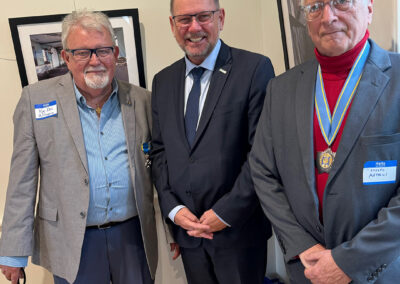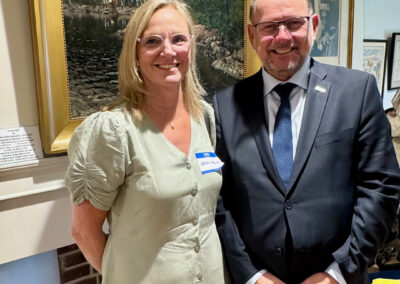The festivities began on Saturday May 4th at 2 PM on the first floor of the Lazaretto. After a welcome to a standing room only crowd by Governor Joe Mathews, the Historian and Curator, Rev. Dr. Kim-Eric Williams gave a detailed history of the Society and its different homes. Then the Honorable Urban Ahlin, Ambassador of Sweden to the US gave an excellent presentation about the present situation in Sweden. He kept everyone’s attention with his insights and humor. The Society then presented gifts to him and his wife, a copy of the SCS Photo history of New Sweden, a Philadelphia city flag in Swedish colors and a baseball cap also in Swedish Colors for the Phillies. Pat Barr of the Tinicum Township Commissioners presented him with an official Tinicum tee shirt with a picture of Gov. Printz.
The actual dedications of the Art Gallery and the Study Center followed on the second and third floors. Prayer was offered by the Rev. Dr Maria E. Erling, Professor of Modern Church History and Global Mission at the United Lutheran Seminary in Gettysburg/Philadelphia. Dr Erling is a graduate of Yale and Harvard, a fluent Swedish speaker and a published authority on Swedish immigration. Then Ambassador Ahlin and Governor Joe Mathews cut the ribbons and visitors enjoyed viewing both the Art Gallery and the Study Center.
Following time spent in the Art Gallery and Study Center people congregated again on the first floor to enjoy a very generous Fika provided by Capozzoli Caters and organized by Ruth Nelson Rizzi.
When the Swedish Colonial Society moved its Art and Archives to a new location at the historic Lazaretto in Tinicum township, over 115 years of collecting came into public view for the first time. All of these discoveries can now be enjoyed regularly on the first Saturday of each month from 11 am to 2 pm.
Visitors will see the original life-size oil painting of the famed Governor of New Sweden, Johan Printz. This is a copy of an original in Sweden painted in 1660. It was painted by King Gustaf V’s personal painter and sent to the Swedish Colonial Society at its founding in 1909. Before this no one in this country knew what this famed 400-pound courageous and proud Governor actually looked like. Now his image is even on the Tinicum township seal and flag.
Also exhibited are portraits of Lapowinsa and Tiscohan, the only known. Images of Lenape leaders from the 18th Century. The artist’s self-portrait is also shown, Gustavus Hesselius- one of the first portrait painters in the Delaware Valley and a man of deep Christian faith. His father was a Lutheran Pastor in Sweden and his two brothers both served as pastors at Holy Trinity, Old Swedes Church in Wilmington. His respect for the Lenape is plainly visible in their portraits and reminds us that the New Sweden colony was the only European settlement to have a mutually beneficial relationship with the original inhabitants.
Did you know that 17th Century maps had south on the top and north at the bottom? And that all the Lenape names for geographical features can be seen in a map created by Per Lindeström in 1655?
The large wooden ship model of the man-of-war, Vasa shows us that Sweden was indeed a European Super Power in the 1600’s. expanding its borders and profiting by the Thirty Years War. This unbelievably large vessel sank in Stockholm harbor and was raised and restored 95% intact in the 1970’s. Two other historic ship models remind us of: Finland’s participation in the New Sweden Colony and the Chinese trade that Sweden profited from in the 1800’s.
Famed sculptor. Carl Milles made a 6’ 9” model of a monolith that was never actually executed. Neither funds nor a location were available for a “Sweden and America” monument in 1948. However, the model is fascinating with Milles sense of humor showing Viking ships, Christian missionaries, a Pipe organ, Governor Printz, Queen Christina riding on a horse, and even the Vatican where the Queen was received after renouncing the throne of Sweden.
In a locked case may be seen a copy of the 1695 Hymnal used by the first settlers. The kind of regalia worn by members of the Swedish Colonial Society is also shown plus a collection of 16th and 17th Century Swedish coins, together with a membership card for President Franklin Delano Roosevelt.
Fans of Taylor Swift will enjoy seeing a letter and photograph from Jenny Lind, the first mega-star female touring singer in America (1850).
Framed on the walls are color phots of nearby Swedish colonial sites. Including three of the eight churches, the Landing at Wilmington in 1638, and still- existing log structures that illustrate that the Swedes introduced log cabins to this country. Historians will appreciate seeing famed scholar Amandus Johnson’s secretary desk and hand-carved Swedish mahogany chairs.
All of these are located in the second floor Art Gallery and even more art is on the third floor, in a Study Center and Archives. Over the fireplace is a 42” x 27” forest scene by Swedish Impressionist artist Per Erik Arborelius (1842-1915) and 1938 life-size photographs of King Gustaf VI Adolf and Queen Louise, well-known visitors to the Delaware Valley in 1926 and 1938. In addition to other framed art there is a picture of George Washington, that is rarely seen, painted in 1794 by Adolf Ulrik Wertmüller. It is probably more realistic than the one on the Dollar bill since he shows him in a definitely regal pose.
















